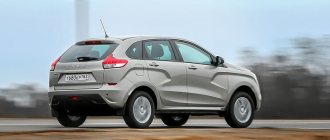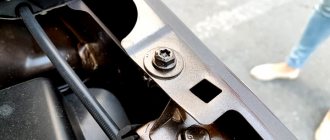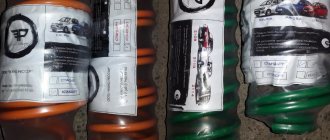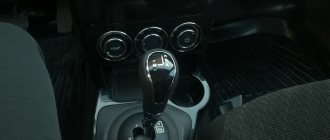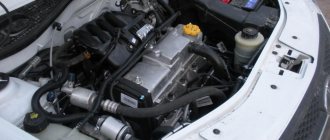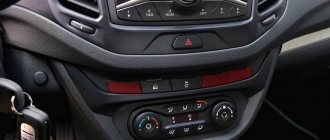Big test drive of Lada XRay in Sochi (video)
Opinion of recognized experts
In order to understand the feasibility of purchasing a particular car model, a potential buyer often resorts to ready-made auto reviews of various printed and video publications. The “Big Test Drive” program for the Lada X-Ray will be an excellent opportunity for every domestic car enthusiast to evaluate in advance all the strengths and weaknesses of the new front-wheel drive hatchback proposed by the AvtoVAZ concern.
The essence of the transfer
The Big Test Drive project was founded in 2012. Its initiator was Sergei Stillavin, who, together with Rustam Vakhidov and Vladimir Pastukhov, regularly conducts independent test drives of popular car models. Therefore, not a single new model on the Russian car market is hidden from their attention.
This video review of the new Lada XRay model will allow each viewer to personally evaluate the high hatchback offered by the AvtoVAZ concern, relying not on advertising descriptions of a seller interested in buyers, but on the personal opinion of impartial masters of their craft. As a rule, viewing a full episode takes one hour. During this time, the presenters manage to fully convey to their viewers the experience of their long acquaintance with each car. The video review from Stillavin and Vakhidov will be extremely interesting to those people who are still thinking about the advisability of purchasing this front-wheel drive hatchback, which resembles an SUV in its outline and size. You can watch this episode of the “Big Test Drive” about the Lada X-Ray from Stillavin and Vakhidov from YouTube in the video below.
Big test drive of Lada XRay in Sochi (video)
The “Top” configuration, equipped with a 122 horsepower engine and a robotic automatic transmission (AMT), was taken as a “test” model of the Lada X-Ray in Sochi. This choice was not made lightly: the maximum package includes domestically produced transmissions, unlike others, which include a French five-speed manual transmission and a Japanese engine.
For this reason, this issue of the “Big Test Drive” of the 2016 Lada XRay, alas, does not consider more budget modifications available to most domestic motorists. Nevertheless, the review has great practical value, as it allows us to identify advantages and disadvantages in the operation of the main systems and components of the car, as well as possible shortcomings in the operation of numerous built-in electronic systems. It is worth noting separately that the introduction of electronics is to a certain extent a novelty for the AvtoVAZ concern - before the discovery of the “second wind”, which marked the release of the Vesta and X-Ray models, the cars produced were much simpler.
Also, the presenters of this program took upon themselves the responsibility to check the ease of use of all the functionality included in the maximum “Top” package.
About convenience and safety
Correspondents of the magazine “Behind the Wheel” started a video test drive of the Lada X Ray 2017 not only to reveal the characteristics of the car’s behavior on the road, its off-road qualities, and to evaluate its appearance. The first and main goal was to check how safe it is and to evaluate its convenience. Here the Lada also showed its best side, demonstrating good equipment.
Safety includes seat belts for all passengers and the driver, as well as airbags on the front side.
As part of the test drive, the Za Rulem magazine team even tested them for performance.
It turned out that everything worked flawlessly.
Convenience. Upon closer inspection, controls for all electronics are easily visible in the cabin. There are also electric windows, side mirror adjusters, and an entertainment system control manipulator. The X-ray is also equipped with an on-board computer and climate control. All this is located so that it is convenient for both the driver and passengers to reach them. For the first, this is especially important - it does not distract from driving. It’s nice that you can customize not only the seats, but also the steering wheel – by angle and reach.
But the luggage compartment could be larger. Its volume of three hundred and ten liters may not be enough for a large family. But there is enough space for two if you fold down the rear sofa. This increases luggage space to 1200 liters.
The adjustment systems of the Lada X-Ray behavior control systems sometimes behave incorrectly on the road. When going uphill, the traction control system can also interfere, dampening the engine speed. The directional stability system has increased sensitivity. VAZ specialists must not have known about these problems, and they did not provide the ability to disable electronic assistants or configure them independently. We can only hope that over time all these shortcomings will be corrected.
At the end of the video review - test drive Lada X Ray, it’s worth expressing the editors’ impressions of the car. Considering the cost, the car turned out to be decent. It is possible to give up some of the features and take a cheaper version, but with a more powerful engine. In this regard, the cost will not differ much. Let everyone decide for themselves whether bonuses are needed for the most complete “Comfort” version.
Necessary accents
The first thing that caught the eye of the presenters of the “Big Test Drive” was that the production Lada XRay is very different from concept No. 1, presented at the show in 2014. The outlines of the car have become smoother, the front optics have lost their angularity and become less aggressive. This is not an advantage, but also not a disadvantage - the production version of X-Rey was created on the basis of concept No. 2 and has a number of fundamental differences from concept No. 1.
The presenters considered a slight change in stamping relative to the concept as a drawback of the exterior. The X-shaped stamping on the front and rear wings has become more expressive and more prominent, which is a definite plus. However, the decorative stamping, located centrally in the lower part of the sides of the body, according to the presenters, looks more bad than good. The fact is that in the light it creates extra glare (this is noticeable with a glossy body paint), which is why the sides of the car look as if it had been in a minor accident and received some damage.
Another disadvantage of the external design was the wheels. With such a massive body, they seem completely toy-like, which is why the car looks somewhat disproportionate. This problem, of course, can be solved - but to do this you will have to replace the existing disks with a larger diameter, purchasing an additional set of low-profile tires.
The electronics built into the functionality of the car also raised a huge number of questions, because they do not have the ability to turn off (for the most part). Since the test drive was carried out in the vicinity of Sochi, in the vicinity of highways of various types, it was possible to “roll out” the electronics everywhere - from straight highways to narrow twisted mountain serpentines.
Questions were raised, first of all, by the traction control system, which turns off the engine when the wheels slip. This setting increases the chance of loss of dynamics when driving on a slippery slope - although in conditions of a relatively flat road and on descents, this system performed well. The presenters also paid considerable attention to the exchange rate control systems, which sometimes work too actively, braking the engine even at extremely low speeds.
Video presentation of Lada X Ray and Lada Vesta at the Moscow Motor Show 2014
The presentation is led personally by AvtoVAZ President Bo Andersson
When the LADA XRAY appeared, it inherited from its donor the B0 platform not only advantages, but also a lot of disadvantages, which gave rise to constant criticism. And now, with the advent of the XRAY Cross version, it’s time to work on bugs and eliminate shortcomings. And indeed, this is not just a new version, but in many ways a different car, since a lot of work has been done.
Even in appearance there have been changes for the better, although only black plastic linings have appeared along the lower perimeter of the body and increased ground clearance. But this was precisely what the ordinary “Xray” lacked. The wheel arches seemed small and made the car look excessively plump. Now, the black edging along the arches visually enlarges them, and large 17-inch wheels and increased ground clearance further lift the car, changing the proportions and making the appearance more proportional and harmonious. The bumper and radiator grille have also changed a little, but this is not noticeable. Now the XRAY is more like a crossover, although it is still only front-wheel drive and will not have all-wheel drive.
Big test: Kia Rio X-Line, Renault Sandero Stepway, Lada X-Ray Cross
The method of converting an ordinary hatchback into a cross-hatch is quite simple: a couple of centimeters to the ground clearance, due to extended springs and shock absorber rods, plus a plastic body kit along the lower perimeter of the body. The Kia Rio X-Line and Renault Sandero Stepway are made using this recipe. The Lada X-Ray Cross has two orders of magnitude more differences from the donor Xray. In addition to new elastic elements “all around”, there is an original front subframe coupled with levers and steering knuckles. And also a new Kaluga electric power steering.
Cross differs from the usual Xray not only in its body kit and wheels, but also in its bumpers with continued x-shaped stampings
The front track of the X-Ray Cross is wider by 19 mm, and the rear by 54 mm. It’s curious, but the initiators of the broad gauge were not engineers, but the main VAZ artist, Steve Mattin. The Englishman insisted that the wheels of the cross-hatch be closer to the arches, so, according to the master, the car looks solid and solid. Who would argue! In addition, Mattin wanted to install 18-inch wheels on the Cross, but after discussion the factory workers agreed on a compromise R17 shoe. Which is also not enough for a compact B-class machine. For example, Kia and Renault are equipped with wheels one size smaller.
The angular design of the front panel of the Lada is not for everyone. However, unlike Renault, the steering column is adjustable for tilt and reach, which provides the driver with a more comfortable position
Instrument cluster with radial digitization and color backing to match the body
Climate control with a small, hard to read display
Front seats with optimal cushion length and back profile. But I always want to lower them lower
The rear sofa of the X-Ray Cross is slightly shifted towards the wheel arch, and the backrest is more vertical than in regular X-Rays. But the measures taken do not correct the crampedness of the second row
Among the test participants, only the VAZ SUV has an off-road assistant. The Lada Ride Select system is also responsible for activating the sport mode. In addition, there are new front seats and a reach-adjustable steering column. Even though the range of movement of the telescopic mechanism is only 42 mm, but these are precisely those millimeters that allow you to straighten your limbs and find a more comfortable fit than in the co-platform Sandero.
The Lada Ride Select system will not replace mechanical all-wheel drive, but it should not be considered a useless trinket either. We checked - the assistant really helps off-road
Among the minor changes to the interior: personalized door sill plates, an instrument cluster with an orange backing, as well as heated steering wheel and seats. Moreover, the front heaters are three-mode, with an automatic reduction in heating intensity. Ordinary Xray does not have these. Finally, the Cross has improved interior sound insulation. In addition to reducing noise itself, this also had a positive effect on the sound of the standard audio system. With the same components as Renault, the “music” in Lada plays more detailed and deeper.
Recent restyling has refreshed the appearance of the Stepway, adding gloss to the inexpensive hatchback
The Sandero Stepway, built on the same imperfect B0 platform as the X-Ray Cross, did not have a reach-adjustable steering column. The driver's seating position is aggravated by a non-optimally shaped seat: the cushion is very short, the backrest does not support the body well, and the headrest does not provide support for the back of the head. There is also no rear view camera, which is present in expensive versions of Lada and Kia, as well as heated steering wheel and rear sofa. But on the second row there is a little more space than in the co-platform Xray, and the “seat” itself with soft filling is more comfortable.
There are no differences in the interior of the Stepway from the regular Sandero. The plastic is hard, but the quality of the materials is quite decent
The instrument cluster is overloaded with small risks. The speedometer is digitized in the French style - in odd steps
The Logan/Sandero family is not provided with full climate control. Automatic air conditioning is available as an alternative
Only a driver with long limbs and a stooped back will be able to sit comfortably in the seat.
The second row of the Renault is more cramped than in the Kia, but a little more spacious than in the Lada, due to the less voluminous front seats
But passengers will be most comfortable in a Kia. In terms of space in the second row, the Rio X-Line is a record holder. And it’s a shame for the driver to complain, there’s a perfectly shaped seat underneath him. Before your eyes is a readable instrument cluster with large scales, the ergonomics are thought out to the smallest detail: all the knobs and buttons are in their places, you don’t have to look for anything. It’s a pity that the display of the multimedia system is small and located almost vertically. The screen glares mercilessly in the sun. However, Renault and Lada suffer from the same sin.
The regular Rio hatchback is not presented in Russia; an alternative to the sedan is offered with the pseudo-off-road X-Line package
We also note that the Kia has the easiest seating position, like a regular Rio - you won’t have to get used to it or relearn it. Drivers of the co-platform Sandero Stepway and X-Ray Cross sit noticeably higher above the road. On the one hand, the captain's seat provides better visibility, on the other hand, there is a certain feeling of detachment from the car. Over time, you get used to this feature, but at first you subconsciously reach out with your hand to the seat adjustment jack to lower it lower.
Ergonomics are thought out almost to the smallest detail, but it is useless to look for soft plastic in the interior of the Rio X-Line
The instrument cluster is an example of functionality
In expensive trim levels, Kia is equipped with single-zone climate control
Driver's seat with an optimal profile and a range of adjustments
There is more space on the second row of Kia than in Renault and Lada
Renault has the widest selection of power units. In addition to the old K4M engines (1.6 l., 82 hp and 1.6 l., 102 hp), the range includes a Nissan engine of the same volume (113 hp). And transmissions, as they say in the range: “mechanics”, “automatic”, variator. Kia has two engines (1.4 liters, 100 hp and 1.6 liters, 123 hp) and two six-speed gearboxes: manual and automatic. But the Lada has an alternative to the naturally aspirated 1.8 liter. (122 hp) coupled with a five-speed manual transmission no. “Robot” AMT, like the 1.6 engine, is in the future.
Renault Sandero Stepway
Kia Rio X-Line
Lada X-Ray Cross
From a marketing point of view, the lack of a two-pedal modification is a serious problem. But physically, X-Ray Cross with its “mechanics” is far from perfect. To get moving without a jerk, you have to work brilliantly with a completely uninformative accelerator and a long-stroke clutch. Make a slight mistake and Lada jumps. The lightweight gas pedal makes it difficult to drive in traffic jams, as well as on dirt roads when you need to drive through an uneven section at a snail's pace.
Handling with pepper. When turning, the rear axle turns the cross-hatch along the vertical axis. However, you don’t have to worry about skidding, thanks to a well-tuned stabilization system
The 1.8 engine is also a thing in itself. At idle, it not only loads the controls with vibrations, but also fills the cabin with a loud and not very pleasant rumbling sound. Up to 2000 rpm, the engine with index 21179 sleeps soundly, making it impossible to move under pressure. But having passed the three thousand mark on the tachometer, it wakes up with active pickup, which does not turn sour until the electronic cutoff. In general, driving X-Ray Cross is much easier and more interesting than driving at legal speeds.
When driving, the voice of the engine prevails, drowning out the noise of the tires and the howling of the wind.
There are no questions about the manual transmission. The moves are small, the selectivity of the lever is a solid “four”. It's a pity there are only five gears, and quite short ones. Having accelerated, you just want to tuck in the non-existent sixth stage in order to muffle the obsessive noise of the engine and reduce its appetite. Still, nine liters “per hundred” in the combined cycle is a bit much for such a compact car.
Renault reacts to gas with noticeable delays. Acceleration dynamics are the most modest of the test participants
However, the 113-horsepower Sandero Stepway at the same speed consumes about 0.3 liters more. And if you get stuck in a traffic jam for half a day, “ten” will appear on the display of the instrument cluster. At the same time, Renault is not distinguished by any outstanding dynamics: not dense, but not empty either, in general - average.
But the Nissan CVT, which they began installing on Stepways after restyling, sometimes deserves a strong word. No, the unit itself is not bad in principle: it skillfully simulates gear changes, does not smear snot on the pulleys during intense acceleration, and even brakes with the engine when the speed decreases. However, due to unsuccessful settings of the electronic software, it reacts to the fuel supply with indecent thoughtfulness; in order to achieve any noticeable acceleration, the gas pedal has to be pressed as much as halfway. But even after this you have to wait: first the engine speed increases and only after that the car begins to reluctantly accelerate.
The Renault suspension provides less comfort than the Lada and especially the Kia, but at the same time its interior is better insulated from external noise than others
Rio X-Line does not require sacrifices. You put the selector of the classic automatic transmission into drive, add traction with precise accelerator, and the Korean “sneaker” gently takes off. Whether you want to accelerate smoothly or burn rubber by slipping wheels, Kia easily accepts any rules of the game. Moreover, it always carries out commands, as the driver expects. Well, almost always.
I would still like the connection between the power unit and the drive wheels to be stronger. Well, or at least the presence of a Sport mode that sharpens the responses, so that you can influence the relationship with the engine. “Automatic” cannot be blamed for the smoothness of switching – everything is smooth here, but their frequency is sometimes annoying. Downshifts occur with every slight fuel supply, that is, the gearbox does not allow the engine to spin up within one gear. Meanwhile, the strength of the Korean “aspirated” 1.6 is quite enough. And he does not suffer from a brutal appetite - 8.6 liters per 100 km.
In corners, the Rio X-Line demonstrates enviable stability and neutral behavior. Steering wheel feedback increases uniformly with steering angle
The Kia is driven reliably. The steering wheel is almost weightless at low speeds, but becomes heavier as speed increases, allowing you to drive the car in a straight line without wobbling or steering. When the steering wheel deviates, feedback also appears. Body roll in corners is not scary, having reached the limit of tire grip, the Rio X-Line safely moves to the outside of the turn while drifting the front wheels. In a word - an excellent student.
When in motion, the interior of the Rio X-Line is filled with tire noise
Sandero Stepway drives differently. The steering wheel is unreasonably heavy in all modes, instead of feedback there is a thick background force. And the roll in corners is the most noticeable of the whole trinity. Somehow I don’t feel like rocking a Renault. But the X-Ray Cross itself seems to be urging the driver to rush along the winding path. Even if the Lada steering wheel has too high a return force, it still provides the most honest information about the position of the steered wheels. In fast corners, the rear axle turns the crossover slightly, shifting the handling balance towards redundancy. But a strict stabilization system protects it from slipping.
An impressive ground clearance of 215 mm and short body overhangs provide the Lada with better geometric cross-country ability. With the Ride Select system activated, the crossover easily passes where Renault and Kia give up
Kia Rio X-Line
Renault Sandero Stepway
Lada X-Ray Cross
Kia has the most modest ground clearance - 190 mm. Renault has only 5 mm more under the bottom, but in fact the Stepway is better suited for off-road use. The clearance of the Lada will be the envy of other SUVs - 215 mm. At the same time, the Cross has the shortest travel rear suspension
Who is the most comfortable in our trio? Again – Kia! The suspension is a little stiffer than that of the Rio sedan, which is especially noticeable on bumps with sharp edges, but it deals with the rest of the road problems quite confidently. True, in terms of energy intensity of elastic elements, Renault and Lada are superior to the “Korean”; this pair irons large holes without breakdowns or impacts. The X-Ray Cross is especially successful in this, as it copes well with both deep potholes and speed bumps. And this is on “seventeenth” wheels!
Kia Rio X-Line
The Kia luggage compartment with a simple finish can accommodate 390-1075 liters of luggage. Full-size spare wheel under the floor
Renault Sandero Stepway
The Renault trunk, with a volume of 320 liters, is finished more neatly than in the Kia, but lacks fittings in the form of hooks and pockets. There is a full-size spare wheel in the niche.
Lada X-Ray Cross
Only the Lada trunk has a two-level floor.
But even if you remove the partition, the volume of the compartment will be a modest 361 liters. The spare wheel is full. The Sandero Stepway's suspension is less omnivorous. If a wheel gets into a hole, the comfort in the cabin almost does not suffer, but if there is a bump or the same speed bump in the way, it shakes so much that you can bite your tongue. Apparently, due to body lifting, Renault shock absorbers work differently during rebound and compression. But what’s interesting is that as soon as you take the Stepway onto an uneven country road, not a trace remains of the discrepancy. You can rush through potholes at full speed. X-Ray Cross is no worse under the same conditions, but Rio X-Line lags behind. Due to the lower ground clearance and the impressive front overhang behind the wheel, the Kia has to choose routes more carefully, and sometimes look for detours.
News Media2

